
Opal Gemstones: History, Symbolism, Meanings & More
 If you’re interested in opals, you’re in for an exciting ride. Opal is a versatile jewel with a complex history that spans across the globe. Actually, beyond the globe, since opal was discovered on Mars in 2015!
If you’re interested in opals, you’re in for an exciting ride. Opal is a versatile jewel with a complex history that spans across the globe. Actually, beyond the globe, since opal was discovered on Mars in 2015!
Nobody on earth holds opal in greater esteem than Australians. As the world’s number-one supplier, Australia takes great pride in their opals, even naming it their national gemstone in 1993.
Beyond Australia, opal holds many honors. The stone is the official gem for 14th wedding anniversaries and the traditional birthstone for October! More into the zodiac calendar? If you’re a Libra, opal is your lucky zodiac stone!
Want to learn more? In this guide, we’ll answer all your questions about opals, from the scientific to the symbolic.
Before we jump in, let’s lay some groundwork.
What is Opal?
Opal is a mineraloid composed of silica and water. Most opals you’ll come across are 6-10% water. Stable opals can have as low as 3% water content and as high as 21%.
Under a microscope, opal contains stacks of hydrated silica spheres aligned together like a Buckyball cube. The spheres of a precious opal are uniform in size and pattern, while common opal spheres vary in size and don’t align in a structured pattern.
The consistent spacing among precious opal’s spheres allow light to diffract, creating its signature play-of-color. Common opals, by definition, don’t show play-of-color but do show opalescence. Opalescence is an optical phenomenon where the stone’s shine seems to glow from within, rather than on the surface.
Opal hardness ranks between a 5 to 6.5 on the Mohs scale of mineral hardness, similar to stones like turquoise and moonstone.
Read on for the full list of opal’s mineral characteristics!
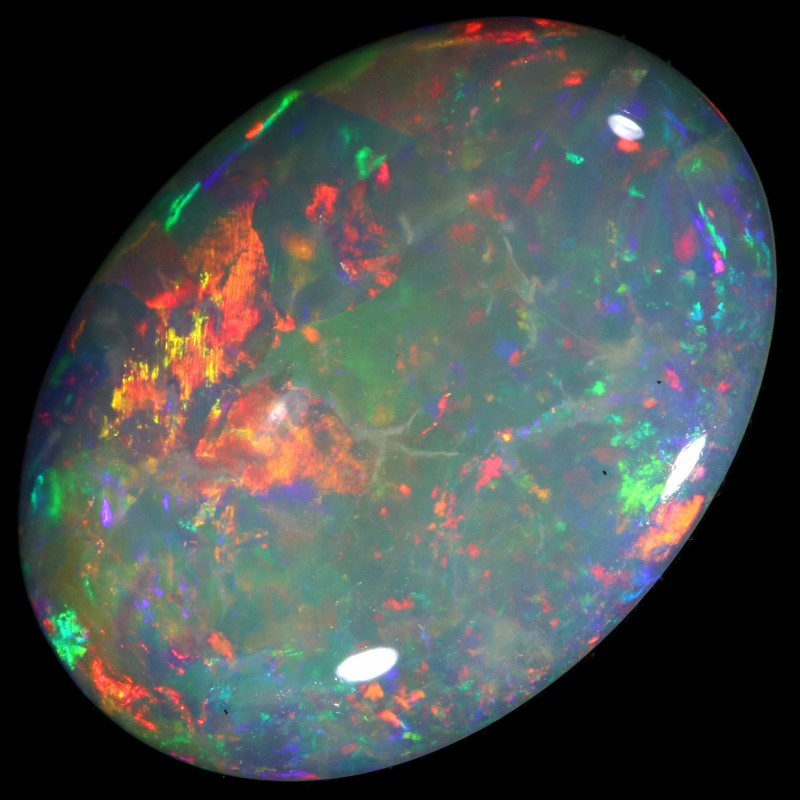
Specifications
Color: Colorless, white, black, yellow, orange, red, pink, green, blue, pink, brown
Crystal structure: Amorphous
Hardness: 5-6.5
Luster: Subvitreous (somewhat glass-like) to dull
Transparency: Transparent to opaque
Refractive index: 1.37-1.47
Density: 1.9-2.3
Cleavage: None
Fracture: Conchoidal to uneven
Luminescence: Sometimes phosphorescence; Fluorescence (Yellow-green in short UV, white or light blue in long UV)
Enough with the science, let’s get into opal’s fascinating history!
Opal History & Symbolism
Based on available evidence, opal history began in the Bronze Age, inside a Kenyan cave around 4000 B.C. Here is where archeologist Louis Leakey discovered the earliest known opal remnants in 1938.
Throughout time, different societies have had their own opal discoveries. Ancient Greeks and Romans adored opal; they called it opallios, meaning “to see a change in color.”
As time passed, nobles began wearing opal as well.
In the Middle Ages, an opal graced the center of the Roman Emperor’s crown, referred to as “the Orphanus” for its enchanting mystery. England’s Queen Victoria I loved opals, often collecting and gifting opal jewelry.
However, opal history was temporarily stained by superstition. Starting in the 1830s, people believed opals were bad luck, and even worse? Heralds of death.
The most likely source of opal’s bad rep was Sir Walter Scott. In his 1829 novel Anne of Geierstein, a suspicious woman’s opal hair clasp loses its color when touched by holy water, followed shortly after by her death.
Scott’s novel wrecked the opal market, causing sales to decrease by 50% and stay there for decades.
That’s when Tullie Cornthwaite Wollaston came in.
Wollaston heard about Australian opal discoveries in 1888 and jumped at the opportunity. Taking parcels to London, Wollaston was met with suspicion, save for diamond-tycoon De Beers.
Slowly but surely, Wollaston introduced Americans and Europeans to black opals. When Percy Marks created an award-winning jewellery collection from Australian black opals in 1908, opal popularity shot back up to its rightful spot.
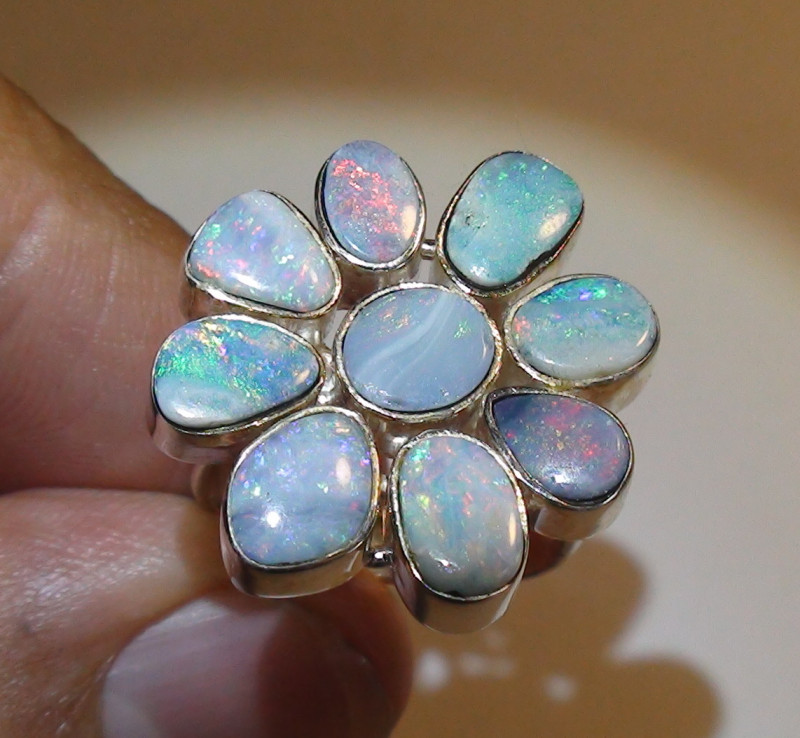
Opal Symbolism
While opal symbolized bad luck and misfortune for a time, that period was a blip in opal’s symbolic timeline. Before the 19th century myths, many societies saw opal as a good luck charm. China, for instance, has always believed in the lucky powers of opal.
Opal symbolism also went beyond everyday luck and into mystical territory.
Beliefs about opal’s vision-related powers spread in ancient times. Some believed opals could cure eye diseases, while others claimed carrying an opal wrapped in a bay leaf could turn you invisible.
Think invisibility is wild? How about astral projection?
Expanding on opal’s magical abilities, the stone was purported to connect one’s physical body to the spiritual dimension. In this way, opal served as a conduit for out-of-body experiences. Black opal even gained a reputation as a powerful tool for magicians.
Other cultures associated opal with their respective deities, viewing the stone as a celestial gift. Ancient Arab legends say opals came from heaven through lightning, while Peruvians saw opals as a gift from Pachamama, the Inca goddess of fertility.
In modern times, spiritual practitioners use opal for accessing psychic abilities. Opal is generally seen as a healing stone that symbolizes inspiration, confidence, and emotional healing.
If you’re itching to try opal’s spiritual benefits, follow along to learn what makes a good-quality opal gemstone before you buy your own!
Quality and Buying Factors
Determining an opal’s value is tricky, as each stone can greatly differ from the next. A full opal quality evaluation requires an expert eye. However, there are still plenty of clues for everyday buyers to look for when choosing an opal gemstone.
Color
We’ll go more in-depth about opal color in a bit, so we’ll give you some general tips for figuring out an opal’s quality by its color.
The first step is looking for play-of-color. Since precious opals are rarer than common opals, play-of-color means higher value. Of course, play-of-color can range from a few spots on the surface to an entirely rainbow-covered stone like boulder opal. The best play-of-color covers most of the surface and shows a variety of saturated colors.
For common opals, the rarity of the color typically determines the value. White opals are the most common, followed closely by gray and green body tones. The rarest colors are black opal and red opal.
Clarity
Gemstone clarity means how many inclusions are present and how visible the inclusions are. Note that not all inclusions lower the stone’s value, as many opals get their body tone from substances intermingling during formation.
The inclusions that affect an opal’s clarity grade are host rocks or fractures. When opals attach to other stones during formation, like in matrix opal or yowah nuts, its value usually decreases. Crazing, fractures, and cracks all make an opal less durable.
Transparency can also affect clarity, as transparent opals are very rare and command higher prices, but it depends on the variety. For example, black opal has higher value when the stone is opaque. In general, cloudy body tones indicate lower quality.
Cut
Unlike color and clarity, an opal’s cut is chosen by a lapidarist instead of Mother Nature. The highest-quality cuts come from experienced cutters who know how to bring out the opal’s color or color-play effectively.
Custom cuts are of higher value, as they’re only used on high-quality opals and require more craftsmanship. The more abundant varieties, like common opals, often become standard cabochons.
Whether the cut is custom or standard, try to look for thicker, symmetrical cuts.
Carat Weight
Since rough opals come in a wide range of sizes, carat weight plays a much smaller role in opal quality. If two opals are identical by all other quality measures (which isn’t common), the stone with a higher carat weight will be more valuable.
We’ve mentioned the array of opals out there, so let’s get into more detail about the best opal varieties.
Types of Opals
Seeing all the different types of opals to choose from might be overwhelming. To make it easier, we’ll lay out the key opal varieties to know about.
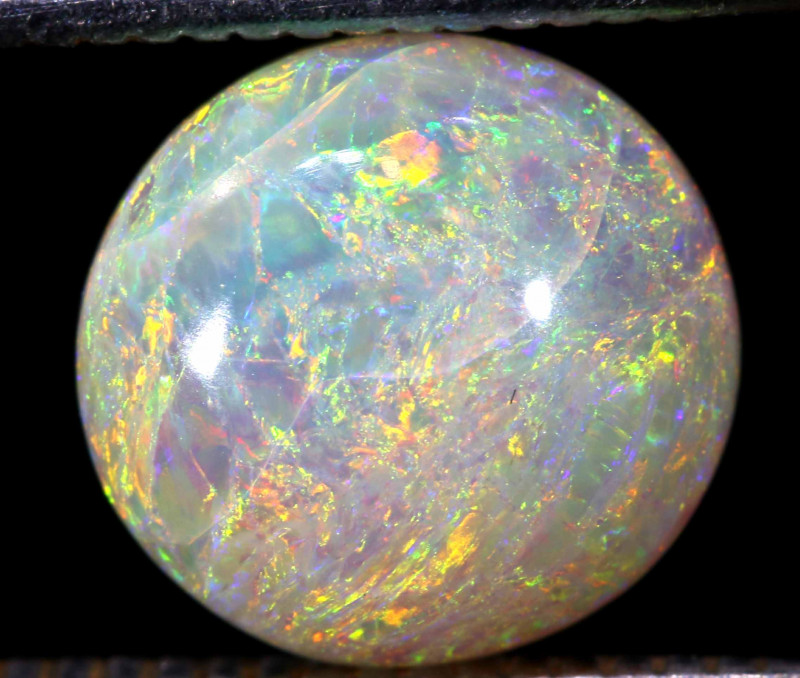
White Opal
White opal, or light opal, can come in common or precious varieties. The lighter background means the stone’s play-of-color isn’t as saturated. Numerous locations produce white opal, but South Australia is the most famous locale.
 Black Opal
Black Opal
Black opals are the most coveted opal variety. Common black opal exists but doesn’t carry the same value of precious black opal. Against the dark background, color play is vivid. Lightning Ridge, Australia, and Honduras are known for their black opals.
Crystal Opal
Crystal opal can describe any type of opal that’s transparent, be it light or dark body tones. Australia and Ethiopia are the most abundant sources.
Fire Opal
Fire opals can technically come from all over, but the official one is the Mexican fire opal. These opals come in common and precious varieties and show saturated, warm body tones.
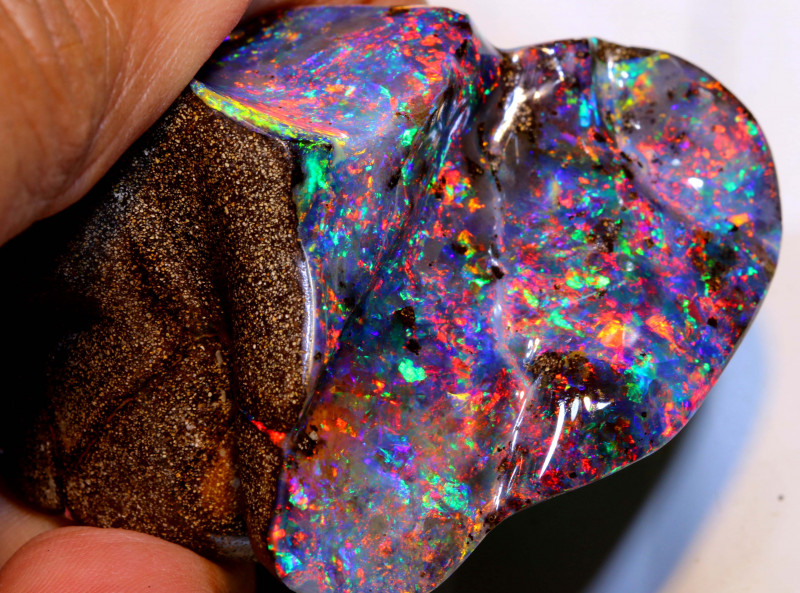
Boulder Opal
Boulder opal refers to precious opal that’s still attached to a host rock, with the opal within or on top. The rock serves as a natural backing, and when the rock is dark, the play-of-color appears brighter. Nearly all boulder opal is mined in Queensland, Australia.
Matrix Opal
Similar to boulder opal, matrix opal refers to precious opal that’s interwoven with its host rock. The host rocks are usually sedimentary, where the silica-water disperses throughout the rock’s crevices before solidifying.
Some host rocks are igneous, where the silica-water often replaces mineral grains. Sedimentary matrix opal comes from Andamooka, Australia, while igneous matrix opal is mostly found in Honduras.
Not all opals are created by nature, however.
What about Synthetic Opals?
Synthetic opals are man-made opals composed of microscopic silica spheres, typically hydrated silica but not always. Synthetic opals may contain resin, while resin-free synthetic opals are called “created opals.”
Scientists started creating synthetic opals in the 1970s and have developed various methods since. Two popular types of synthetic opals are Monarch Opal and Bello Opal.
One important distinction: synthetic opal is not the same as imitation opal. Synthetic opal requires the same chemical structure and refractive index as natural opal, while imitation opals are made of other materials like resin or plastic.
Opal Colors
Opal colors range between solid neutrals like black and white to multi-colored rainbow tones. Few opals display just one color, however.
Precious opals, by definition, reflect different colors at different angles. Even common opals, which don’t have play-of-color, often have colored inclusions or patterns, like the dark branches in dendritic opal.
The main causes of different play-of-color hues are the size and uniformity of the stones’ microscopic spheres, plus the angle you view the stone from.
An opal’s body tone, or background color, plays a role in the other colors visible on its surface. White is the most common opal color, while black and red are the rarest.
Here are the most popular opal colors and their corresponding surface colors:
White: White or cream-colored body tone; Reflects pastel colors.
Black: Black or dark-colored body tone; Typically reflects bright greens and blues.
Pink: Rose, salmon, or ballet pink body tone; Sometimes has dark orange or black speckling.
Blue: Bluish-gray, cyan, or midnight blue body tone; Often has streaks of orange or earth tones.
Fire: Bright red, orange, or yellow body tone; Precious variety typically reflects neon shades of green and purple.
So, how much will each of these opal varieties cost you?
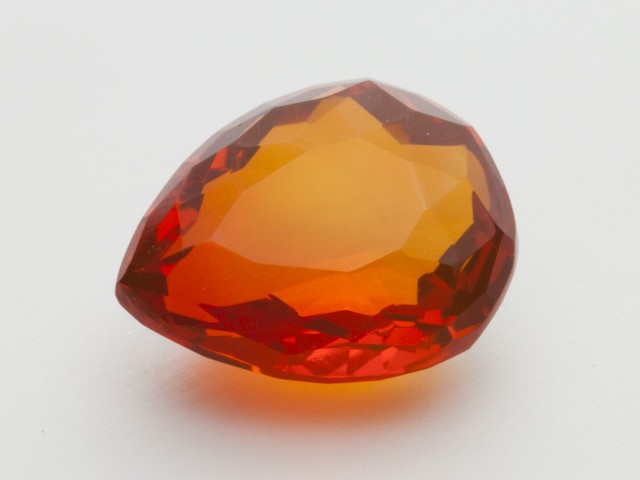
Opal Value
As you know, lots of factors go into valuing an opal. When determining price, color is the first key factor, followed by the presence of play-of-color.
The price per carat for opal varies as much as opals themselves. Lower quality stones can be around $10 per carat, while the higher-quality opals can run $6,000 or more per carat.
Precious black opals command higher prices for their rarity and bright play-of-color, reaching $10,000 per carat or more. Common opals are much more affordable, starting at $10 per carat and increasing based on color intensity, transparency, and brilliance.
Regardless of price, knowing how to clean opal is essential to keeping it colorful and intact.
Cleaning & Caring for your Opal
For most opals, you can clean the stone with a soft brush and warm, soapy water. Hot water, soaps, and oils won’t harm your opal unless it’s a doublet or triplet. Doublets and triplets should be cleaned with a soft cloth.
Opal can sometimes darken if you heat it, so keep it away from open flames or excessive heat to preserve the color and longevity.
Certain varieties have their own care guidelines. Matrix opal is porous and shouldn’t be soaked in anything for long. Virgin Valley opal, on the other hand, should be soaked in water to prevent crazing.
Discover the Opal for You!
And that’s it! With all the juicy facts and tidbits in this guide, you’re ready to impress anyone with your extensive opal knowledge. Plus, you have the tools to buy with confidence once you’ve chosen your favorite opal. Happy shopping!
Shop for Opals from Opal Auctions today!
Search the Opal Encyclopedia
Related Auctions
Related Articles
Australian Black Opal is one of the rarest gemstones on earth. It has every color of the rainbow on a black ground which makes the colors dance.
8th May 2018
Boulder Opal is one of the most undervalue opals valuable on the market. Learn more about this unique opal and browse the beautifully stones we have for sale.
29th May 2019
With a passion for opals, Wayne and Estella Sedawie established Opal Plus more that 14 years ago and have found the internet to be a valuable tool. It’s where most of the company’s international transactions take place.
17th Oct 2018
Latest Articles
An opal’s price comes down to a variety of factors, all of which we’ve broken down in this guide to opal grading and prices. Learn all about opal grading and the prices of each type of opal!
19th Jul 2023
Come on a journey and learn about the healing power of opals from our guest writer Vivien Schapera from Crystal Healing Techniques!
20th May 2023
The Flame (or Fire) Queen opal is the world’s most expensive opal, sold for the modern equivalent of $3 million dollars. Learn all about its history and qualities!
18th Feb 2023
Article Categories
All there is to know about Opals including Black Opals, Ethiopian Opals & Boulder Opal
15 Articles
Check out our fascinating information and articles on all things amazing in the Opal world
43 Articles
Opal Auctions sellers who are approved as opal Verified Sellers
4 Articles








